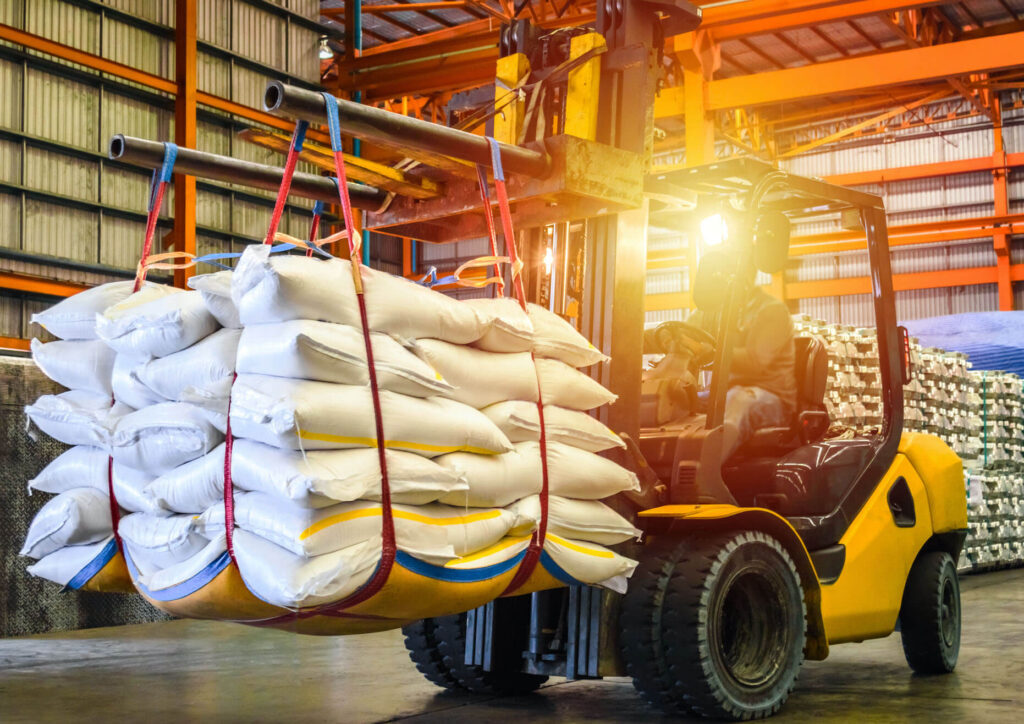Using the right kind of lifting equipment is important when handling different materials. It’s more than just convenience – it also provides strategic and safety benefits. Carefully handling materials with precision also allows industries to optimize packaging. This ultimately contributes to initiatives aimed at sustainability and reducing packaging waste. From forklifts to gantry cranes, various specialized machinery has revolutionized how industries lift, transport, and position materials.

For instance, both food safety and food quality are essential when it comes to food production. Lifting equipment is a key factor in ensuring that food products remain safe and of high quality from the time they enter the processing stage until they reach their destination.
Types of Lifting Equipment for Smoother Material Handling
Here are the various types of lifting equipment that help ensure smoother material handling:
1. Forklifts
Forklifts are motorized industrial trucks equipped with forks at the front for lifting and transporting materials. They use hydraulic systems to raise and lower the forks.
The operator can control the movement and direction of the forklift to position and transport materials. Forklifts commonly lift pallets of goods, crates, and other heavy or bulky items.
2. Overhead Cranes
Overhead cranes are large, fixed machines that use a horizontal beam (bridge) to move a trolley along a runway, allowing for the lifting and moving of heavy loads. These are typically operated by a pendant control or a cabin.
They use hoists or other lifting attachments to raise and lower loads. Overhead cranes are usually used to lift steel beams, large machinery, and heavy equipment.
3. Scissor Lifts
Scissor lifts are mobile platforms that can be raised vertically using linked, folding supports beneath the platform. The scissor mechanism extends and retracts, allowing for vertical movement. Some models also have an extending platform for additional reach. They lift workers for tasks at height, maintenance equipment, and materials in warehouses.
4. Telescopic Handlers (Telehandlers)
Telehandlers, or telescopic handlers, are versatile machines with a telescoping boom for lifting and placing loads. The telescopic boom extends and retracts, and some models may also have attachments such as forks or buckets for different tasks. They usually lift pallets, construction materials, and tools.
5. Pallet Jacks
Pallet jacks, also known as pallet trucks, are manual or electric devices with forks used for lifting and moving pallets. Manual pallet jacks are operated by pumping a handle to lift the forks, while electric ones use a motor. They’re used to lift pallets of goods within warehouses or distribution centers and are typically maneuvered by the operator pushing or pulling.
6. Conveyor Systems
Conveyor systems transport materials from one point to another using belts, rollers, or other moving surfaces. Materials are placed on the conveyor, and the system moves them along a predefined path, eliminating the need for manual lifting and carrying. Conveyor systems boxes, packages, and other small to medium-sized items.
7. Gantry Cranes
Gantry cranes are similar to overhead cranes but are supported on legs that run on wheels or along a track on the ground. They use a horizontal beam to lift and move heavy loads.
Gantry cranes are often used in outdoor settings or areas without overhead support. They can lift containers, large machinery, and bulk materials.
8. Vacuum Lifters
Vacuum lifters use suction cups to grip and lift materials, typically in a sheet or panel form. The vacuum lifter creates a seal between the suction cups and the material surface, and a vacuum pump is used to lift and move the material. They can lift glass panels, sheet metal, and other flat materials.
9. Mobile Cranes
Mobile cranes are truck-mounted or crawler-mounted cranes that can be easily transported to different locations. They use a telescopic boom or lattice boom for lifting heavy loads. These are versatile and suitable for various applications. Mobile cranes can lift construction materials, machinery, and components.
10. Hydraulic Lift Tables
Hydraulic lift tables can be raised or lowered using a hydraulic cylinder. Hydraulic cylinders extend to lift the table and retract to lower it. They’re often used for ergonomic positioning of materials or equipment. Hydraulic lift tables can lift heavy equipment during maintenance, pallets, and materials in manufacturing settings.

Importance of Using the Right Lifting Equipment
Using the right lifting equipment is crucial for several reasons. It’s pivotal in ensuring efficient, safe, and precise material handling in various industries.
Here are some key points highlighting the importance of using the right lifting equipment:
- Preventing Accidents: The right lifting equipment is designed and engineered to handle specific loads and tasks. This reduces the risk of accidents, injuries, and damage to materials.
- Operator Safety: Properly matched equipment enhances operator safety by minimizing manual handling. They help reduce the physical strain on workers, and provide a stable and controlled lifting environment.
- Preserving Materials: The right lifting equipment helps preserve the integrity of the materials being lifted. For example, delicate or fragile items can be handled with specialized equipment like vacuum lifters to prevent damage.
- Accurate Positioning: Precision in lifting is essential for accurately positioning materials. This is crucial in manufacturing processes where components need to be aligned correctly.
- Adaptability to Tasks: Different lifting equipment is designed for various tasks and environments. Choosing the right equipment ensures adaptability to the job’s specific needs, whether it involves heavy lifting, reaching heights, or handling fragile materials.
Summary
Different types of lifting equipment are available to help you handle various materials. Each equipment has its own benefits, which allow you to choose the best one for your needs. Selecting the right equipment is important since it ensures efficient, safe, and precise material handling.
Article by: Jeanicka Rhey


 Copyright 2017-2023 All rights reserved.
Copyright 2017-2023 All rights reserved.